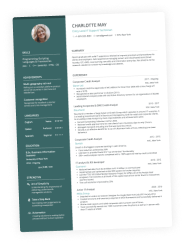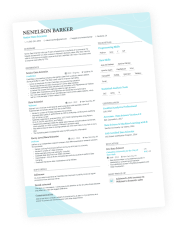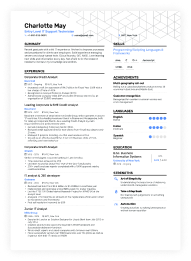Traditional Resume Templates
Traditional resume templates are the best option for executive positions or jobs in traditional, professional fields such as accounting, engineering, logistics, etc. Start customizing your own classic resume template with the options below.

Ivy League
The Harvard template, updated for the 21st century, boasts a sleek design that is well-received by recruiters and an improved structure for better performance in applicant tracking systems.

Timeline
The Timeline resume template is designed to showcase the progress of your career in an organized manner. It's perfect for experienced professionals looking to make a lasting impression.

Elite
A resume template that features a refined layout that impresses recruiters and an optimized structure for superior ATS performance.

Single Column
This simple resume template is available for free and optimized to be easily read by both human recruiters and ATS bots.
What is a traditional template resume?
There are tons of different types of resumes, but traditional or classic resumes are most commonly used. It is usually up to a two-page document with a brief description of your work experience, strengths, achievements, and educational background. This type of business document has a simple layout without flashy graphical elements and colors and is easy to be read and scan by recruiters. It only includes texts highlighting your key achievements.
As a job-seeker, you can no longer create resumes for human eyes alone. While your resume should still look great to recruiters and employers, it first has to pass the initial screening done by the ATS. Because of its simplicity, a traditional resume will pass any Applicant Tracking System (ATS) scanning process.
You can create such a resume by using a traditional resume template in a resume builder.
When to use a traditional template resume?
The majority of recruiters and employers are used to classic-looking resumes. In some cases, the hiring manager will expect you to submit a traditional resume. These resume formats are popular with jobseekers applying for work in conservative workplaces, like law firms or other corporate fields, such as finance or the nonprofit world. The basic design of the traditional resumes makes them look more business-appropriate and helps you appear straight-laced and professional.
As much as your resume should present your abilities and professional experience, its design should show you’ve researched your prospective employer’s company culture. When applying to more conventional companies, you should match their corporate culture with your resume. The traditional template is likely to help your chances of being hired in such companies.
When writing a resume, focus on including an uncomplicated professional summary, work history, skills, and education sections. Traditional resume layout is simple, but it can be powerful when you put additional qualifications and achievements. Do not make a compromise with the information in your resume’s simple look.
What makes a traditional template resume
The traditional resume is with a simple layout and follows a strict format, generally beginning with a header, title, and contact details. The document continues with your professional summary, followed by your professional work history, and finishes with your educational information and relevant skill sets.
- Traditional resume templates do not use any colors except some shades of black and gray. That is proven to be effective because it keeps recruiters focused on the content of your resume instead of how it looks.
- Times New Roman is widely considered the most classic and traditional font to use in this template. The classical resume template at Enhancv builder conveys professionalism by using Lato as a primary font in different sizes and styles.
- To ensure a better reading experience, use a lot of white space around all objects and sections. That also allows you to emphasize crucial details easily.
- The background in the classic-looking resume is always clear. Keep the document free from graphics, adhere to the corporate style.
- The classic resume template follows a traditional formatting structure that’s the best fit for jobs in professional environments. And it uses heading, subheadings, bolded words, plus bullet points to keep all the information organized.
- The header section comes at the top of the page to display your most important contact details. That includes your full name, job title, phone number, address, etc.
- We placed the summary section below the header to help you market yourself and highlight your best qualities.
- Experience and education are listed in reverse-chronological format with precise dates and locations. That helps recruiters notice your growth and career progress in a well-structured fashion.
- Accomplishments and skills are featured to allow you to stand out from the crowd by highlighting your unique qualities and relevant job history.
- The tone of voice you use should be highly professional, serious, and straightforward. Your message needs to come across as intelligent, critical and focused.
- Including a photo on your traditional resume is a question that depends on the country in which you are applying to work. When in doubt, we suggest not including a photo unless they deliberately ask for a picture as part of your application.
Tips to build the best traditional resume:
Design
Traditional resume template is with simple design, less use of color and graphics or visual elements. A black and white business document with simple headers and a straightforward layout. The simple styling is to outline your experience, education, and outstanding skills.
Visual separations of sections are achieved by a lot of white space around all objects and sections. The design is following strict business formatting and structure with bold headlines to ensure good readability.
Font
Choosing the right font for your traditional resume is very important. You will never go wrong with Lato or Oswald.
Colors
Traditional resumes do not use any colors, which is considered distracting and unprofessional. However, using darker colors like navy blue or gray in a classic-looking resume is considered acceptable. A good suggestion is to personalize your resume for the company you are applying to is to use their corporate colors.
Select the best layout
Working with already made traditional templates for your resume will help you to keep the design clean and the formatting business-appropriate. The header of your resume must contain your name, your contact information, and links to your business website or profile on LinkedIn. Place your headshot only if specifically mentioned in the job application.
Adding a summary or profile section to your resume will help you present yourself to your future employer. This section of your resume should include a summary of your previous experience, skills, and future goals related to a specific job opening. Use a highly professional, serious, and straightforward tone of voice. Keep your summary short but, at the same time, try to emphasize your best qualities sought-after by the recruiters.
The following section to include on your traditional resume is your work history and experience, which should be clear and concise yet descriptive.
The prospective employer should know your responsibilities, what skills you have developed, where your strengths lie, and what you have achieved. Begin each item by stating the company name, location, dates, and job title.
List your experiences in chronological order by starting with the most current position. Use bullet points to describe your experience using concise statements led by strong verbs, representing your responsibilities and accomplishments concerning the job itself.
The traditional resume template is not an eye-catching document. That's why the information you write must be informative as possible and emphasize your professionalism and abilities. It is advisable to add achievements, accomplishments, or awards sections on your resume. Showcasing your strengths and talents can help you land the job you are applying for. And serve as an indicator to an employer that you have a strong work ethic or skillset.
Your traditional resume will need to include an education section. There is some basic information that should be included within this section, like the name of the school, graduation year, degree, and major field or department of study.
List your education can be essential for advancing into the next phase of the hiring process. Consider listing your certifications separately from the education section on your resume. Another benefit is that certifications may be the key to beating ATS systems and making your resume more attractive than the competition.
As the last section on your resume, you can list with bullet points relevant skills set. In this classical-based resume formatting, it’s not advisable to include any different or creative information if it’s not specifically mentioned in the job description. Traditional resumes should follow a pretty strict structure – there’s not much room to improvise here.
Most resumes should be a maximum of two pages long, a standard length to fit your summary, work history, experience, and skills.
In a traditional resume, you should keep your text in one column. Your resume can be one page if you have fewer than ten years of relevant work experience. However, if you are more experienced in your industry, you can make a two-page resume to elaborate on that experience and showcase all of your job skills and qualifications.
Traditional resume template pros and cons
Pros
- The traditional resume template speaks well to most employers as it directly informs employers of your skills and abilities for the job while following a format of highlighting your most recent work experience to the past.
- It's scannable by applicant tracking systems (ATS) to ensure a 100% pass rate.
- Use traditional a resume when applying within the government and more conventional employers. A Classic resume format is a good choice if you have a steady work history, and you can highlight your stability and currency within your chosen field.
Cons
- The main disadvantage is the resemblance with the other resumes. You can’t be creative and get the employer’s attention if you have to write a traditional resume.
- You can’t be creative and add some additional information about your experience to put you in front of other applicants.
- In a traditional resume, you have to get your whole career history condensed into one or two pages, which makes it hard to outline all of your abilities.





